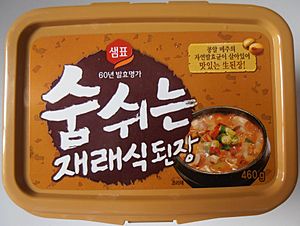Doenjang-jjigae facts for kids
 |
|
| Alternative names | Soybean paste stew |
|---|---|
| Type | Jjigae |
| Place of origin | Korea |
| Associated national cuisine | Korean cuisine |
| Main ingredients | Doenjang |
| 160 kcal (670 kJ) | |
| Korean name | |
| Hangul |
된장찌개
|
|---|---|
| Hanja |
-醬--
|
| Revised Romanization | doenjang-jjigae |
| McCune–Reischauer | toenjang-tchigae |
| IPA | [twen.dʑaŋ.t͈ɕi.ɡɛ] |
Doenjang-jjigae (Korean: 된장찌개) is a popular Korean stew. It is also known as soybean paste stew in English. This tasty dish is made mainly from doenjang, which is a special fermented soybean paste.
People often add other ingredients like vegetables, seafood, or meat. Doenjang-jjigae is one of the most famous dishes in Korean cuisine. Many Koreans eat it regularly, no matter the time of day.
Long ago, people made doenjang at home. Today, most households and restaurants use doenjang made in factories. This makes it easier to get and use. Doenjang is a very important sauce in Korean cooking. It is even called a national dish.
Sometimes, doenjang-jjigae is confused with doenjang-guk (soybean paste soup). The main difference is how they are cooked and served. Jjigae is thicker and has more ingredients. It is usually served as a main dish. Guk is thinner and served more like a side soup with rice.
Contents
History of Doenjang-jjigae
The main ingredient, doenjang, has a very long history. It dates back to the Korean Three Kingdoms period. Korea was mostly a farming country back then. People had lots of farmland but not much meat, especially in winter.
To get enough protein, Korean farmers started making pastes from plants and seeds. This is how doenjang was first made. It came from fermenting soybeans into a block called meju. This fermented soybean paste was a great source of nutrients.
The first official mention of doenjang is in an old book called Samguk Sagi. This book recorded events from the Three Kingdoms era. It says that doenjang was served at the wedding of King Sinmun in 683 CE.
The earliest form of doenjang-jjigae was a dish called ‘curled mallow soup’. This soup is mentioned in an old Korean farming book, Jeungbo sallim gyeongje. It was written by a doctor named Yu Jung-Rim during the time of King Youngjo (1724 – 1776).
Curled mallow soup used mallow leaves and other vegetables. These were boiled in a broth with doenjang. It was served as a soup with rice. Over time, different parts of Korea created their own unique doenjang-jjigae recipes. Many of these varieties are still enjoyed today.
What Goes into Doenjang-jjigae
There are many ways to make doenjang-jjigae. The ingredients can change depending on the province where it's made. Here are the common ingredients you'll find in most doenjang-jjigae dishes:
- Doenjang (fermented soybean paste)
- Dried anchovies
- White radish
- Korean chili pepper
- Minced garlic
- Water
- Onions
- Green onions
- Potato
- Zucchini
- Medium-firm tofu
In the past, doenjang-jjigae was made with homemade soybean paste. Making doenjang at home was common, much like making kimchi. But now, most doenjang is made in factories. This makes it quick and easy to get for cooking.
You can also add other ingredients to make the stew heartier. Meat and seafood are popular choices. These additions change the taste of the broth. So, the dish might get a slightly different name. Common seafood additions include prawns or small clams. Beef is the most popular meat to add.
How to Make and Serve It
Making doenjang-jjigae has two main steps. First, you make the broth. Then, you add the other ingredients.
To make the base broth, you add dried anchovies and white radish to water. You boil this for about 15 minutes. Next, you stir in the doenjang and chili pepper. Mix it well. Let the broth boil for another 10 to 20 minutes. After that, you filter out the anchovies.
Now it's time to add the other ingredients. First, add potatoes and zucchini. Give them time to soften. Then, add onions, green onions, and tofu. Finally, add minced garlic for a stronger flavor.
Unlike doenjang-guk, doenjang-jjigae is served in the middle of the dining table. It's meant to be shared by two or more people. Like other jjigae dishes, it comes with steamed rice. It also comes with other banchans (side dishes) like meat or vegetables.
Doenjang-jjigae is often served with Korean barbecue. Many people think that barbecued meat and doenjang-jjigae make a delicious and satisfying meal together.
Different Kinds of Doenjang-jjigae

Korean cuisine has many kinds of doenjang-jjigae. Each one has its own unique taste and look. They can also be different depending on the region. These varieties are usually named after their special main ingredient.
- Kkot-Gae (Swimming crab): Crab shells and legs are added to the broth. The crab makes the stew taste sweet and rich.
- Cha-Dol-Bae-gi (Beef brisket): Fried beef brisket is added to the broth. It boils with the other ingredients. This type is often served at Korean barbecue restaurants.
- Bajirak (Clam): Cleaned clams are added to the cooked doenjang-jjigae. This gives the stew a deeper, savory taste.
- Sundubu (Curdled soft tofu): Soft tofu can be used for a very smooth stew. This is often a good choice for children.
- Dallae (Korean wild chives): Dallae is added to the broth just before it boils. The chives give the stew a strong, slightly herbal taste.
- Naengi (Horseradish): The leafy roots of horseradish are briefly boiled in hot water. Then, they are added to the cooked doenjang-jjigae for a spicy flavor. Horseradish is good for you, with lots of protein, calcium, and iron.
- Gang-Doenjang: First, vegetables are stir-fried with doenjang and gochujang (chili paste). Then, a small amount of water is added. It boils until the stew becomes very thick.
See also
 In Spanish: Doenjang jjigae para niños
In Spanish: Doenjang jjigae para niños




